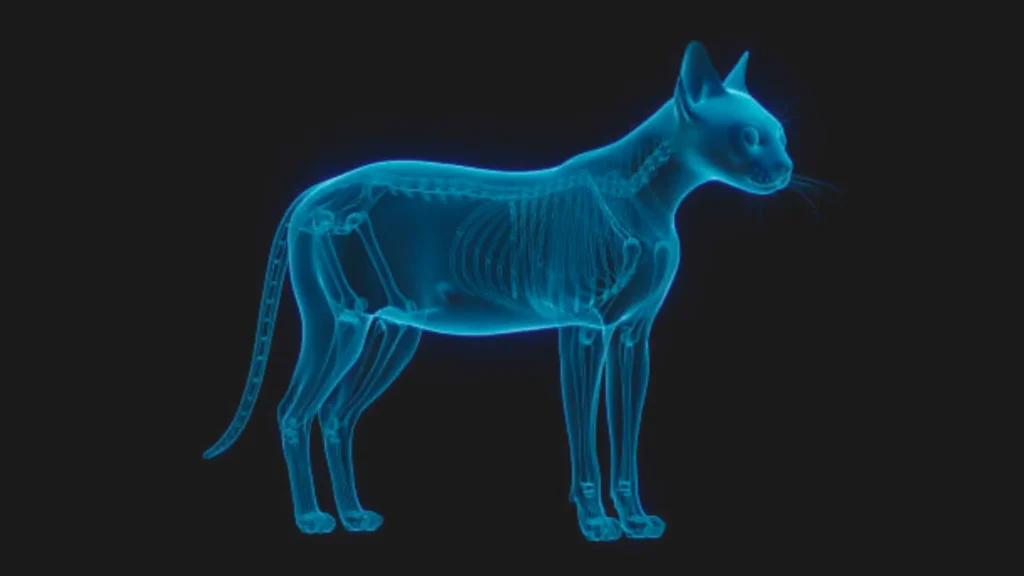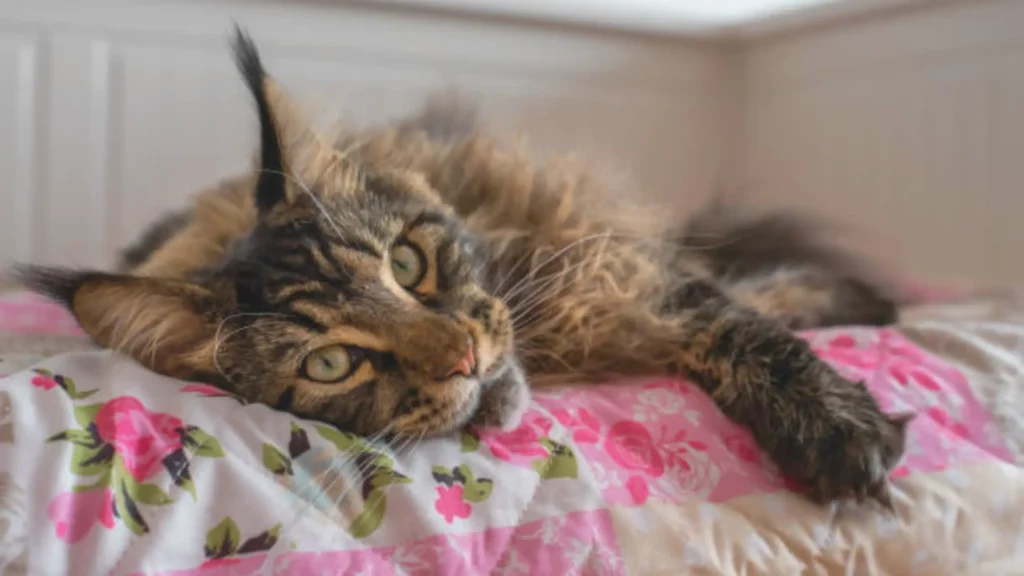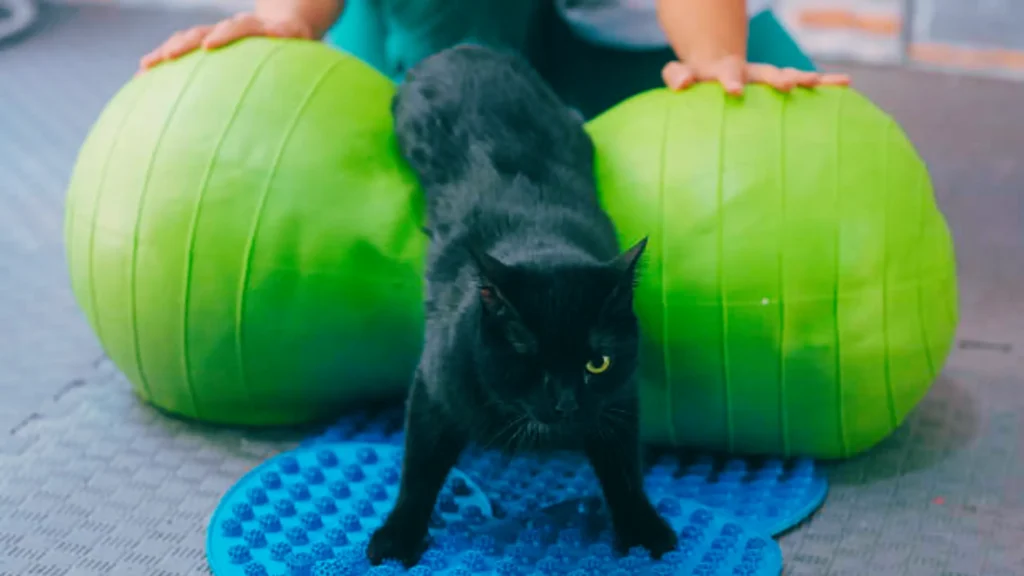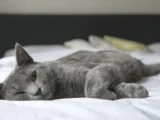
Challenges of An Older Cat With a Bony Spine
As your cat grows older, you might start noticing changes in their behavior. One common issue in senior cats is spine health. A bony spine in older cats can lead to a lot of discomfort, affecting their mobility and overall quality of life. You may notice your once sprightly cat becoming stiff, having trouble jumping, or even avoiding play. This could be a sign of arthritis, spinal degeneration, or bone loss—conditions that become more common as cats age.
Senior cats are at higher risk for these problems, and it’s crucial to address them early on. So, what can you do? In this article, we’ll explore the challenges of caring for a cat with a bony spine and discuss ways to improve their comfort. Whether you’re seeing early signs or have an aging cat already dealing with these issues, we’ve got you covered with tips to help them move more freely and live more comfortably.
What causes a bony spine in older cats?
As cats age, their spine naturally undergoes wear and tear, much like any other part of their body. The bone density starts to decrease, making their spine more vulnerable. A bony spine in older cats isn’t just about bones looking thinner—it’s about loss of strength, and that can cause discomfort, stiffness, and pain. It’s more common than you might think, especially in cats who are past 7 years old.
How does age affect the spine and joints in senior cats?
The older your cat gets, the more likely they are to develop conditions like osteoarthritis, which impacts the joints. Over time, their spine may start to show degenerative changes, like bone spurs (bony growths) or spondylosis—a condition where the bones in the spine begin to fuse together. This makes it harder for your cat to bend or move comfortably.
If you’ve noticed your cat avoiding jumping, running, or climbing, it could be due to spinal stiffness caused by these natural aging changes. It’s the body’s way of limiting movement to prevent further damage or pain.
Is arthritis the main cause of spine problems in aging cats?
Yes, arthritis is a huge factor in spine issues in senior cats. In fact, degenerative joint disease (DJD), which includes osteoarthritis, is one of the top reasons older cats suffer from spinal pain. Arthritis causes inflammation in the joints, leading to pain, reduced flexibility, and stiffness. This can affect the spine and limbs, making even simple movements uncomfortable for your cat.
Other conditions can contribute, but arthritis is by far the most common cause of mobility problems in aging cats. It’s also often paired with other issues like muscle atrophy—the weakening of the muscles around the spine, which makes it harder for your cat to move.
What are the signs of spinal problems due to aging?
Signs can be subtle but worth noting:
- Decreased activity: Cats with spine issues may move less or avoid jumping onto high places.
- Changes in posture: You may notice your cat arching its back or walking stiffly.
- Pain or sensitivity: If your cat meows when touched along the spine or refuses to be petted in certain spots, that could be a red flag.
- Limping or difficulty walking: Cats might have trouble walking straight or show signs of limping when they move.
These symptoms may not always be obvious, especially because cats are great at hiding pain. But when they’re dealing with spinal issues, these behaviors are worth watching.
How can you tell if your senior cat has spine issues?
Spotting spine problems in senior cats isn’t always easy, but there are some key behavioral changes to watch for:
- Stiffness: If your cat is moving slower than usual or avoids certain movements (like jumping), it might be due to spine discomfort.
- Pain when touched: Cats with spinal issues often become sensitive to touch, especially along their back. They may pull away or even growl when petted in certain areas.
- Decreased grooming: Cats with spine problems might struggle to groom themselves properly, especially around the back or tail, as bending becomes painful.
What are the common symptoms of arthritis or spinal degeneration in cats?
Arthritis and spinal degeneration are linked, and they often show up in similar ways:
- Limping or dragging limbs: Cats might limp or drag their back legs when walking. This is common when arthritis affects the spine or hind legs.
- Reluctance to move: Your cat might be less eager to play or climb. These activities require flexibility, and if the spine hurts, they’ll naturally avoid them.
- Difficulty sitting or lying down: Cats with back pain often struggle to sit or lie down comfortably, especially in one position for too long.
- Changes in posture: You may notice your cat hunching or walking with a rigid back, which is often due to stiffness in the spine.
When should you be concerned about your cat’s spine health?
Watch for these warning signs that indicate it’s time for a vet visit:
Muscle atrophy: Over time, cats with spinal problems might lose muscle mass, particularly in the hind legs. This could signal a deeper issue that requires veterinary attention.
Persistent pain: If your cat is vocalizing pain, hiding more than usual, or refusing to eat (due to discomfort), it’s time to seek professional help.
Severe mobility issues: If your cat is struggling to get up or walk, or if they refuse to use the litter box due to back pain, it’s a clear sign of spine issues.
Can spine issues in older cats be prevented?
While we can’t stop aging, spine issues in senior cats can often be managed or slowed with proper care. Here’s how:
- Maintain a healthy weight: Extra pounds put pressure on joints and the spine. Keeping your cat at a healthy weight can help reduce the strain on their back.
- Provide regular, low-impact exercise: Gentle play and movement help keep muscles strong. Encourage your cat to move without pushing them too hard. Short, frequent play sessions are ideal.
- Joint supplements: Adding glucosamine and chondroitin to their diet can support joint health. These help reduce inflammation and slow down the progression of arthritis.
What are some ways to improve spine health in senior cats?
Improving your senior cat’s spine health isn’t just about avoiding damage; it’s about strengthening what they already have. Some useful practices include:
- Tailored diet: Feed them high-quality food rich in omega-3 fatty acids (good for inflammation) and antioxidants (helping to fight damage at the cellular level).
- Physical therapy: Some cats benefit from simple stretches or gentle exercises that a vet or specialist can guide you through. If your cat’s condition allows, therapeutic massage or laser therapy might also help relieve pain and improve mobility.
- Comfortable environment: Set up their living area with low-entry beds, ramps, and easy access to their favorite spots. This prevents the strain of jumping and climbing.
Is there a specific diet or supplement regimen that can help with spine health in cats?
Yes, certain foods and supplements can be a game-changer for a senior cat’s spine health. Here’s a breakdown:
- Joint supplements: As mentioned, glucosamine and chondroitin are must-haves. They help maintain cartilage and improve joint lubrication.
- Omega-3 fatty acids: These are powerful anti-inflammatory agents that reduce stiffness and pain. Look for food rich in EPA and DHA (found in fish oils).
- Antioxidants: Vitamins like C and E, as well as minerals like zinc, can support overall joint health and reduce free radical damage in tissues.
In addition to supplements, high-protein diets that promote lean muscle mass are important to help support a cat’s frame and prevent further strain on the spine.
What treatments are available for senior cats with spine problems?
When your cat shows signs of spinal pain or discomfort, there are several treatment options to explore. Some of the most effective ones include:

- Medications:
- NSAIDs (Non-Steroidal Anti-Inflammatory Drugs): These are commonly prescribed to reduce pain and inflammation. But they should be used with caution in cats—always follow your vet’s advice.
- Corticosteroids: For more severe pain, steroids might be prescribed. These can help reduce inflammation but have potential side effects, so they’re used sparingly.
- Pain relievers: Gabapentin or tramadol might be prescribed for nerve pain, especially if the spine issue involves nerve compression.
- Joint Supplements:
- Glucosamine and chondroitin are key for cartilage support and joint lubrication. These supplements help in both pain relief and slowing degeneration, but they don’t replace pain medications.
- Glucosamine and chondroitin are key for cartilage support and joint lubrication. These supplements help in both pain relief and slowing degeneration, but they don’t replace pain medications.
- Therapeutic Treatments:
- Physical therapy: Regular sessions can help maintain mobility, improve strength, and reduce pain. If your cat’s spine issues are severe, ask your vet about professional physical therapy options.
- Laser therapy: Low-level laser therapy (LLLT) is non-invasive and can help reduce pain and inflammation, promoting healing in damaged tissues.
How effective are pain medications for managing spine-related discomfort in older cats?
Pain medications can be quite effective in managing discomfort, but they’re usually part of a comprehensive treatment plan. While they can help reduce inflammation and relieve muscle spasms, they don’t address the root cause of spine issues. Medications work best when combined with other therapies like physical therapy or joint supplements to promote long-term relief.
One important thing to note: don’t self-prescribe medications for your cat. Always work with your vet to find the right balance of pain management for your cat’s specific condition.
Can physical therapy or acupuncture help a senior cat with spine issues?
Absolutely. Physical therapy is not just for humans—it’s extremely beneficial for cats too. Here’s how it can help:
- Physical therapy: Helps to strengthen muscles around the spine, improving stability and reducing pain. Specialized exercises can improve flexibility and mobility, making your cat more comfortable.
- Acupuncture: This traditional practice is gaining recognition in veterinary medicine. Acupuncture helps reduce pain and inflammation, and can stimulate the body’s healing processes. Some cats respond remarkably well to acupuncture, especially when dealing with chronic pain.
What other treatments should you consider for a senior cat with spine issues?
Environmental modifications: Make your cat’s life easier with ramps, low-entry beds, and non-slip surfaces to prevent falls. This reduces unnecessary strain on their spine and joints.
Weight management: Extra pounds add strain to the spine. Helping your cat maintain a healthy weight through proper diet and portion control is an often overlooked but vital part of treatment.
How can I make my home more comfortable for a cat with spine problems?
Creating a comfortable environment for your aging cat with spine issues is key to improving their daily life. Small changes can make a big difference:

- Low-entry beds: Cats with spine issues may struggle to jump up or down. Invest in beds with low sides or ramps to give your cat easy access to their resting spots.
- Cozy resting places: Ensure your cat has soft, well-padded spots throughout the house where they can relax without putting pressure on their spine. Orthopedic cushions or heated beds are great for older cats with joint pain.
- Ramps and stairs: If your cat enjoys high places but struggles to reach them, ramps or stairs can help. These allow them to get to their favorite spots without jumping, which can strain their back.
What types of bedding and furniture can help cats with spinal discomfort?
Spinal discomfort requires special attention to where your cat sleeps and rests. Here’s what to consider:
- Memory foam: Memory foam beds help support the cat’s body, especially the back and joints. It provides soft, yet firm support for the spine and helps alleviate pressure points.
- Orthopedic beds: These beds are specifically designed for older pets, providing extra cushion for their joints and spine. Look for beds that are both comfortable and easy to clean.
- Non-slip surfaces: As your cat ages, their coordination may decline. Make sure their living spaces are safe by using non-slip rugs or mats on floors to prevent falls.
How can I help my senior cat move around safely and comfortably at home?
Cats with spine issues need to move around without putting unnecessary stress on their bodies. Here are some ideas:
Safe climbing spots: If your cat enjoys climbing, offer low cat trees or shelves. Keep these within easy reach, allowing them to still satisfy their natural climbing instinct without overexerting themselves.
Smooth pathways: Keep floors free of obstacles. Arrange furniture and remove clutter to create clear, safe pathways for your cat to walk along.
Elevated food and water bowls: Position food and water bowls at an elevated height so your cat doesn’t have to bend down too much. This reduces strain on their spine and joints.
How do you know when to see a vet for a cat with spine problems?
Knowing when to get professional help is crucial, especially if your senior cat’s condition is worsening. Here’s when it’s time to make that vet appointment:
- Persistent pain: If your cat is showing signs of ongoing discomfort, like avoiding movement, yowling when touched, or being unusually irritable, it’s time to consult your vet.
- Severe difficulty moving: Struggling to walk, stand, or jump are clear signs that something’s wrong. If your cat can’t get around like they used to, it’s a serious issue that needs professional attention.
- Changes in behavior: Cats that suddenly become more withdrawn or stop grooming themselves may be in pain and need a vet’s evaluation.
What diagnostic tests will a vet perform to assess spine health in older cats?
When you visit the vet for spine concerns, they’ll usually perform a combination of physical exams and diagnostic tests:
- X-rays: To check for signs of arthritis, spondylosis, or disc degeneration in the spine.
- Blood tests: To rule out infections or other health conditions that might be contributing to pain.
- MRI or CT scans: In some cases, these advanced imaging tools help get a clearer picture of soft tissue damage, including nerve issues.
These tests help the vet pinpoint the exact cause of pain, so the right treatment plan can be established.
What treatment options might a vet suggest for spine problems in senior cats?

Depending on the severity of the problem, your vet might recommend one or more of the following:
- Pain management: Expect medications like NSAIDs for inflammation, gabapentin for nerve pain, or even opioids for severe pain.
- Physical therapy: Your vet may suggest physical rehabilitation to strengthen muscles and improve movement without overexerting the spine.
- Surgical options: In extreme cases, surgery may be necessary to correct severe spinal issues like herniated discs or spinal stenosis, but this is typically considered a last resort.
- Joint supplements: If arthritis is a factor, your vet may recommend adding glucosamine or chondroitin supplements to your cat’s diet.
What if the condition worsens despite treatment?
If you’ve been following the vet’s plan, and things still aren’t improving, a follow-up consultation is essential. The vet may adjust the medications, suggest a new therapy, or consider advanced treatments like laser therapy or acupuncture.
Conclusion:
Caring for a senior cat with a bony spine is no small task, but with the right knowledge and strategies, you can significantly improve their quality of life. Whether it’s managing pain with the right medications, providing a comfortable environment, or addressing their dietary needs, small adjustments go a long way.
Spinal health in older cats is crucial, and even though the aging process is inevitable, there’s plenty you can do to keep your feline companion comfortable. Regular vet visits, along with timely interventions like physical therapy or joint supplements, can prevent further degeneration. Don’t wait for the signs to worsen—early detection and treatment are key. By staying proactive and attentive, you’ll ensure that your cat continues to live a happy, comfortable life well into their senior years.
What Is Better Cat Litter Or Pellets? A Detailed Comparison
📚 Sources
- American Veterinary Medical Association (AVMA) – Insights on feline aging and spinal health
👉 https://www.avma.org/resources-tools/pet-owners/petcare/caring-aging-pet - PetMD – Detailed articles on common senior cat health issues, including arthritis and spinal problems
👉 https://www.petmd.com/cat/conditions/musculoskeletal/c_ct_arthritis - Journal of Feline Medicine and Surgery – Research on spinal issues and arthritis in older cats
(Summarized from peer-reviewed studies on feline musculoskeletal disorders)
👉 https://journals.sagepub.com/home/jfm - Vetstreet – General information on senior cat care and spinal health
👉 https://www.vetstreet.com/cats/senior-cats - Feline Health Center at Cornell University – Guide on how to care for senior cats, with a focus on arthritis and mobility issues
👉 https://www.vet.cornell.edu/hospital/feline-health-center - The Journal of Veterinary Internal Medicine – Studies on veterinary pain management for senior cats with arthritis
(Summarized from clinical research on pain management techniques for aging felines)
👉 https://onlinelibrary.wiley.com/journal/20421282


